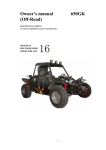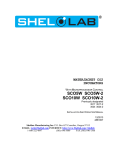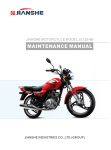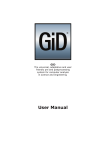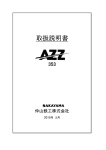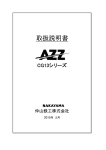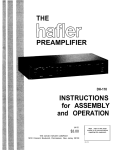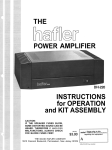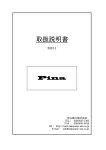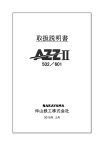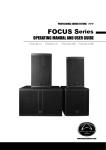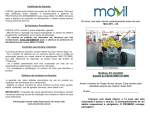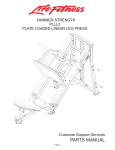Download LJ276M/LJ276MT-2 GASOLING ENGING SERVICE MANUAL
Transcript
LJ276M/LJ276MT-2 GASOLING ENGING SERVICE MANUAL Shanghai Goka Sports Motor Co., Ltd CONTENTS DRAWING Chapter one: Engine technical data and specification……………………………….………..2 1.1 Engine technical data and specification……………………………………………………2 1.2 Petrol Engine External Character Curve…………………………………………………....5 Chapter two: Engine operation……………………………………………………….………..6 2.1 Points for attention in engine operation……………………………………………6 2.2 Running-in of new engine………………………………………………………..6 2.3 Staring, Running and turning off engine…………………………………………...6 Chapter Three: Structural characteristics and assembly requirements of engine ……….8 3.1 Cylinder head assembly……………………….……………………………………………8 3.2 Cylinder block assembly and balance chain………………………………………………9 3.3 Crankshaft and main shaft bearing……………..…………………..………………….11 3.4 Piston and connecting rod assembly……………………………………...……………….12 3.5 Distributor assembly……………………………….………………………………..…….15 3.6 Carburetor assembly…………………………………………..…………………….…….16 3.7 Lubrication system………………………………………………………………………16 3.8 Cooling system……………………….…………………………………………..………..16 3.9 Electrical system…………………………………..……………………………..………..16 3.10 Clutch assembly and transmission assembly……………………………………..……….17 3.11 Engine leakage prevention……………………………………………………..…………18 Chapter Four: Engine maintenance…………………………………………………………..19 4.1 Engine maintenance cycle……………………………………..………………………….19 4.2 Point of attention for engine maintenance………………………………………………20 Chapter Five: Engine main troubles and remedies…………………………….…………….24 Appendix A: Fit Clearances of Main Components………………………..……………………27 Appendix B: Tightening Torque………………………………….…………………………….28 Appendix C: Sealing Surfaces and Sealant……………………………………………………29 1 CHAPTER ONE: ENGINE TECHNICAL DATA AND SPECIFICATION 1.1 ENGINE TECHNICAL DATA AND SPECIFCATION Model LJ276M/LJ276MT-2 Two Cylinders Four -Stroke Water cooled Type In-line Inclined hemispherical combustion chamber Overhead Camshaft valve gear Chain Transmission Bore×Stroke 76×71mm Total Displacement 644ml Compression Ratio 9.0 : 1 Maximum Power /Speed 20.6 KW at 4500rpm Rated Power/Speed 18KW at 4500 rpm Maximum Torque/Speed 49 N.m at 2700~3300 rpm Minimum Specific Fuel Consumption At Full Load ≯280g/KW. h Idling Speed 900±50r/min Counter-Clockwise Direction of rotation (Look from power output) LJ276M Overall Dimension (length×width×height) 795×540×435mm 670×550×525mm LJ276M LJ276MT-2 86 kg 91kg 0.09±0.2 mm (cold) 0.15±0.2 mm (hot) Net Weigh Of Engine Inlet Valve Gap 0.18±0.2 mm (cold) 0.25±0.2 mm (hot) Exhaust Valve Gap VALVE TIMING LJ276MT-2 Intake Valve Opens 23° BTDC Intake Valve Closes 53° ABDC Exhaust Valve Opens 53° BBDC Exhaust Valve Closes 23° ATDC 2 Electromagnetic drive, Unidirectional clutch Closed Starting Mode Crankcase Ventilation Use SE15W/40 petrol engine oil if Ambient Temperature is Above 0℃; Use SE15W/40 petrol engine oil if Ambient Temperature is Below 0 Oil LUBRICATION SYSTOM COOLING SYSTEM Lubricating Mode Pressurized And Splash Type Of Oil Pump Cycloid Rotor Pump Type Of Oil Filter Screwed joint J0706 Oil Capacity(with filter) 2.9L Oil Pressure 0.245Mpa~0.440Mpa(3000r/min ) Mode Of Cooling Forced Water-Cooling Cooling Water Capacity 1.4L Type Of Water Pump Centrifugal Thermostat Wax-Type Type Of Fan Belt AV10×840 Water Temperature 75~95℃ Type Of Air Filter ModelQK1706—00,Paper Element Type of Fuel Pump(electromotion) JB12D—II,12V Model CSH101E FUEL SYSTEM CARBUREROR Double Venturi tube , Single Chamber, Type Balancing Float Chamber Flat Absorb Type Of Choke Valve Manual ELECTRICAL Firing By battery SYSTEM Ignition Timing 10±2°BTDC 900r/min Firing Order 1—2 Ignition Coil Model DQ130,12V Distributor Ignition system SPARK PLUG 3 Model FDW261 Type Magnetic pulse igniter without contact piece Ignition Advance Centrifugal,Vacuum Model F6T 、E6TC Bolt Diameter M14×1.25 Electrode Gap 0.7±0.1mm Model and Type JF132、JF138A, Silicon Rectified Alternator Power Output 14V—30A (Used With Voltage Regulator) Model QD112A,QD115 Power Output 12V—0.8KW ALTERNATOR STARTING MOTOR Battery POWER TRAIN SYSTEM Clutch Model 6—QA-36S Type Single Disc, Diaphragm Spring. Dry Operating Mode Forced Dimension Of Frictional Dise(Outer Dia.×Inner Dia.×Thickness 160×110×7.8 Type Normally-engaged helical synchronous at full speed Mode of operation Floor shift Crankshaft to Transmission main shaft(Normally Engaged drive ratio) 1.6 Transmission main shaft to Lay shaft First Gear 2.413(30/14) Second Gear 1.318(29/22) Third Gear 0.862(25/29) Fourth Gear Reverse Gear TRANSMISSION gears, 2.25(27/12) LJ276M LJ276MT-2 First Gear 3.429 4 Second Gear 2.109 2.8 Third Gear 1.379 1.8 Fourth Gear 1.000 1.0257 Reverse Gear 3.600 3.363 Mileage Counter 14/3 13/3 Lubricant Lubricant Capacity GL—4 Speed ratio 4 0.7L 1.5L Normal modulus Mm Tooth Number Z Spline Data Of The Output Shaft Normal Tooth Pressure angle Normal Tooth Stand-off 1.2 0.75 1.0 18 22 20° 20° +0.8 +0.8 Measure Normal Line w/k 8.412 Measure Span M 20.874 Petrol Engine External Characteristic Curve The Petrol Engine External Characteristic Curve refer to fig. 1-1 Fig. 1-1 5 CHAPTER TWO: ENGINE OPERATION 2.1 POINTS FOR ATTENTION IN ENGINE OPERATION a. Make adjustments and carry out maintenance in accordance with the maintenance methods and rules in this book。 b. Check bonding of earth of battery. Negative terminal of battery is connected to the earth for model LJ276M engine c. When operating new engines, carry out running in accordance with the specification below. Don’t accelerate or overload suddenly 。 d. Keep water temperature within 75~95℃.At medium speeds normal oil pressure should not be less than 245Kpa (2.5kgf/cm2). e. Use RQ—70orRON—90 or above petrol as fuel .When detonation happens. adjust distributor so that ignition timing is retarded properly .It is not allowed to run engine under detonation.。 f. If abnormal phenomenons happen during running, turn off engine and check it without delay g. When draining water from cooling system .to avoid being scalded. don’t open drain plug before water temperature drops。 2.2 RUNNING IN OF NEW ENGINE The service life of engines depends greatly on their initial operating states. When anew engine is installed in a vehicle, The vehicle must be drive for 2500 km in accordance with running in specification. The proposed running in specification is as follows: Mileage km 0~250 250~1000 1000~1500 1500~2500 2.3 2.3.1 Load No load 50% of Rated Load 75% of Rated Load Rated Load Speed Engine Speed Not Over 1600r/min Engine Speed Not Over 2200r/min Engine Speed Not Over 2800r/min Increase Speed Gradually To Maximum Speed In The Operating Gears. STARTING, RUNNING AND TURNING OFF ENGINE PERPARATIONS BEFORE STARTING Do the following before starting engine a Check water level in radiator and reservoir tank, tightening of water pipe connections and tensioning if fan belt b. Check level of Lubricating oil in oil pan。 c. Check fuel quantity in fuel tank and soundness of fuel supply line and connections. Eliminate any leakage。 d. Check level of electrolyte in battery e. Check tightening of connections for battery .alternator, fuel pump, distributor, spark plug, 6 regulator, ignition coils and other electric components. 2.3.2 PROCEDURE FOR STARTING ENGINE A. Set gearshift level to idling position。 B. Move carburetor choke valve near to close position. Then slightly open throttle vale with starting lever so that rich mixture is obtained. C. Step down clutch pedal. D. Turn ignition switch to start position. Starting time should not be over 5 seconds. The interval between two adjacent starts should not be less than 20 seconds. E. After starting engine, release ignition switch immediately so that it goes back to ignition position automatically. At the same time open choke valve partially. With the increase of engine temperature, open choke valve gradually until its fully open position. 2.3.3 STARTING ENGINE AT THE ATMOSPHERIC TEMPERATURE OF LOWER THAN -5℃ When starting engine at low temperature, in addition to above mentioned checks SE10W/30 OE engine oil for winter use and antifreeze coolant should be used. And engine should be warmed up. Steps for Engine Warming Up: A. If Antifreeze coolant is not used. Feed hot water of above 90℃ into engine. B. Feed oil of 80℃~90℃ into engine .The oil should be that which has been drained from engine previously. Draining of oil should be done immediately after engine turn off so that oil is not contaminated. Rotate crankshaft of warmed up engine by hand several turns so that cylinders suck in small amount of fuel. Start engine and run it at idling speed for 2~3minutes. Then run engine from Low load until normal working load .Don’t warm up engine at high speed. 2.3.4 RUNNING ENGINE A. Running in of an engine in a vehicle must be carried out in accordance with running in specification. Don’t start or accelerate engine suddenly at high speed. Avoid overloading engine after running in. B. It is prohibited to run engine when there is no oil pressure, Oil pressure if too low, abnormal noises take place, engine is overheated and abnormal vibration happens. 2.3.5 TURNNING OFF ENGINE It is prohibited to turn off engine at high speed and high load. Before running off engine, Load must be removed. Then run engine at low speed for 3~5 minutes and turn off ignition switch. In icy season, if antifreeze coolant and cylinder block immediately after turning off engine. 7 CHAPTER TEREE: STRUCTURAL CHARCAITERISTICS AND ADDEMBLY REQUIREMENTS OF ENGINE 3.1 CYLINDERHEAD ASSEMBLY Cylinder head is made of high strength aluminum alloy. The shape of combustion chamber is hemispherical. Intake and exhaust runners are distributed on two sides. The overhead camshaft of value train has very good suitability by three bearing in the cylinder head and driven by timing chain. There are the advantages of being stable in transmission, compact in structure and low noise. Rocker arm is made of high strength aluminum alloy with inlaid alloy resists very high temperature. A sealing unit is used for value stem so that engine oil can not enter combustion chamber phase angle between the No.1 cylinder and the No.2 cylinder is 360 degrees crank angle. A. Point for installing timing chain Rotate crankshaft to TDC position before installing timing chain. Then align marks on timing sprocket of crankshaft and camshaft sprocket with the white and bright chain element respectively. Now the locating pin in camshaft should be right at the top position (refer to fig.3-1) B. Locating TDC Rotate crankshaft to make pistons in two cylinders go to their TDC positions in turn. Now the center mark on boss of crankshaft pulley should align with the boss of timing chain cover. Remove cylinder head cover if the locating pin in camshaft sprocket is at the position shown in fig.3-2. The piston in No.1 cylinder is at the position of compression stroke. If locating pin is at opposite position the piston in No.2 cylinder is at TDC position of compression stroke. 8 Fig.3-2 Fig.3-3 C. Tightening and removing cylinder head bolts. The tightening order for cylinder head bolts is shown in fig.3-3.tighten bolts uniformly in three steps. Unfasten are remove bolts in reverse order. requirement Tightening torque 3.2 IGHTENING TORQUE NO.1~NO.6 Bolts 68.6~73.3N·m(Cold)(7~7.5kgf·m) NO.7Bolt 4.9~6.86N·m (0.5~0.7kgf.m) 75.8~83.4N·m(Hot)(8~8.5kgf·m) CYLINDERBLOCK ASSEMBLY AND BALANCE CHAIN Cylinder block is made of alloy cast iron, which has high strength and is wear-resistant .In order to make operation of engine stable and to reduce vibration. Advanced balancing mechanism is adopted .The balancing mechanism consists of counter weights and balancing. Shaft which are ocated on two sides of crankshaft respectively .balancing shaft is driven by a chain. On top surface of the cylinder block marked with cylinder matching group number. at bottom marked with main bearing hole matching group number refer to fig.3-4 3-5 Fig.3-4 Fig.3-5 9 Requirement of matching group is in the table below. Cylinder matching group Group number and mark Main bearing hole matching group Cylinder Group number Cylinder diameterφ76+0003 and mark diameterφ470+0.024 1 ≥0 <+0.01 1 ≥0 2 ≥+0.01 <+0.02 2 >+0.008 ≤+0.016 3 ≥+0.02 ≤+0.03 3 >+0.016 ≤+0.024 ≤+0.008 Main points for installing balance chain: A. Rotate crankshaft to BDC position B. Mark direction of counter weight on balancing shaft to be the same as that of counterweight on crankshaft(fig.3—6) 。 Fig.3-6 The position of counter weights and balancing shaft C. Align the marks (white and bright chain elements) on two balancing shaft sprockets (grooves) respectively (fig.3—7) Then install crankshaft sprocket and two balancing shaft sprocket with balance chain on crankshaft and balancing shaft. 10 Alignment of balancing chain marks (Fig. 3-7) 3.3 CRANKSHAFT AND MAIN SHAFT BEARING 3.3.1 Crankshaft Crankshaft is made of ductile iron .On No.1 and No.4 crank, -each mark with connecting group number, refer to fig.3-8.At the front end of the crankshaft fitted with balancing shaft drive pulley, timing chain and belt pulley ,each used for drive balancing shaft , camshaft , water pump ,alternator, the fly wheel with toothed ring fitted at the end of the crankshaft. Fig.3-8 Connecting rod neck, main shaft neck matching group number 11 Connecting rot neck and main shaft neck matching group number is in the table below: Connecting rod neck matching group Main shaft neck matching group Group and mark Connecting rod neck dimension(Ф400-0.024) 1 ≥-0.024 2 >-0.016 3 >-0.008 Group and mark ≤-0.016 Main shaft neck dimension (Ф430-0.024) 1 ≥-0.024 ≤-0.016 ≤-0.008 2 >-0.016 ≤-0.008 ≤0 3 >-0.008 ≤0 3.3.2 Main shaft bearing Main shaft bearing grouping according to the dimension of centre thickness see the table below: Main shaft bearing matching group Group and mark Centre thickness( 2 Identifying Color +0.006 -0.014 1 Yellow ≥-0.014 2 Green >-0.010 ≤-0.006 3 Brown >-0.006 ≤-0.002 4 Black >-0.002 ≤+0.002 >+0.002 ≤+0.006 5 Blue ) ≤-0.010 When fitting in order to ensure the bearing clearance it needed to matching on group ,the matching relation is in the table blow. Main bearing matching relation Main shaft neck matching group number Main bearing matching group number Main bearing hole matching group number 1 2 3 4 3 2 1 5 4 3 2 6 5 4 3 Note: (1) Main bearing matching group number=main bearing hole matching group number-main shaft neck matching group number (2)Upper and lower bearing should be fitted with the same group bearing set. 3.4 PISTON AND CONNECTING ROD ASSEMBLY Piston is made of special aluminum alloy. There are two gas rings and one oil ring on each piston. The surfaces of the first gas ring and oil ring are chromium plated The second gas ring is slightly conical and serves to proof gas and form lubricating oil zone (when piston is going upwards) and scrape oil (when piston is going downwards). The combined oil ring consists of an upper scrape ring, a lower scrape ring and a compound ring in the middle. The oil ring has radial and axial sealing function and can prevent lubricating oil enter combustion chamber. Piston pin is pressed into the hole of connecting rod with interference. In order to prevent knocking .the hole of piston pin deviates 1mm from supporting and compressing direction. 12 Main points for installing piston assembly: A. Piston and connecting rod assembly matching group ① Requirement of matching group of the piston skirt diameter is in the table below: Piston skirt diameter matching group Group and mark Skirt dimension(Ф760-0.03) 1 ≥-0.030 ≤-0.020 2 >-0.020 ≤-0.010 3 >-0.010 ≤0 ② Requirement of piston matching relation is in the table below: Piston matching relation Engine block piston 1 1 Matching group 2 2 3 3 ③ Requirement of piston pin boss hole matching group is in the table below: Piston pin boss hole matching group Group and mark hole dimension(Ф18 A ≥-0.001 B >+0.002 ≤+0.005 C >+0.005 ≤+0.008 +0.008 –0.001 ) ≤+0.002 ④ Requirement of piston pin external diameter matching group is in the table below: Piston pin external diameter matching group group mark(colored at Piston pin external diameter(Ф180-0.009) internal hole ) A Red ≥-0.009 ≤-0.006 B Yellow >-0.006 ≤-0.003 C Blue >-0.003 ≤0 ⑤ Requirement of connecting rod small end matching group is in the table below: Connecting rod small end matching group Group and mark Connecting rod small end diameter(Ф18 A ≥-0.047 ≤-0.038 B >-0.038 ≤-0.029 C >-0.029 ≤-0.020 13 0.020 0.047 ) ⑥ Requirement of connecting rod bearing matching group is in the table below: Piston pin matching relation Matching group number Connecting rod small A B C Piston pin A B C Piston pin boss hole A B C end ⑦ Requirement of connecting rod big end matching group is in the table below: Group and mark Connecting rod big end dimension(Ф430+0.024) 4 ≥0 ≤+ 0.008 5 >+0.008 ≤+0.016 6 >+0.016 ≤+0.024 ⑧ Requirement of connecting rod bearing matching group is in the table below: Connecting rod bearing matching group Group and mark Identifying color Center thickness( 1.5+0.006 –0.014 1 Yellow ≥-0.014 2 Green >-0.010 ≤-0.006 3 Brown >-0.006 ≤-0.002 4 Blake >-0.002 ≤+0.002 5 Blue >+0.002 ≤+0.006 ) ≤+0.010 ⑨ Connecting rod matching relation is in the table below: Connecting rod matching relation Connecting rod neck group number connecting rod matching group Connecting rod big end group number 1 2 3 4 3 2 1 5 4 3 2 6 5 4 3 Note: (1) Connecting rod bearing matching group number=connecting rod big end matching group number-connecting rod neck matching group number。 (2) Upper and lower connecting rod should be fitted with the same group bearing。 B. When installing two gas ring and the combined oil ring into grooves of piston. Stagger their opening (fig.3-9). The marked surface of the first and second rings should face piston head C .Main points for installing piston and connecting rod assembly. There are fitting marks on piston head and connecting rod shank. Sure that the mark s are in the same direction (refer to fig.3-10) .Be careful to avoid mistakes. 14 D. When installing piston and connecting rod assembly into cylinders. The marked surfaces of the connecting rod and piston must face the front of engine (fig.3-10). Fig.3-8 Relative position of piston rings Fig.3-9 The direction of piston and connecting rod in cylinder 3.5 DISTRIBUTOR ASSEMBLY Distributor is driven by a special bevel gear on crankshaft. The shaft end drives oil pump. Obviously, the installation angle of distributor decides ignition timing .The steps for distributor installation is as follows: A. Rotate crankshaft to TDC position. Then use a screwdriver to turn the groove in shaft end of oil pump (refer to fig.3-11). B. Align the mark on distributor shaft with that on the housing (refer to fig.3-12). C. Align the flat tongue face on distributor shaft with the groove on shaft end of oil pump. Slowly install the distributor into timing chain cover until its shaft inserts into the groove on oil pump. D. Tighten locknuts on the distributor housing and check ignition timing (refer to chapter 4. ignition system maintenance). Gbbcxdffggfdggf Fig.3-10 The position of groove in connecting rod in cylinder Fig.3-11 The direction of piston and oil pump shaft 15 3.6 CARBURETOR ASSEMBLY In order to achieve good power performance and economy with low exhaust gas pollution. Engine is equipped with a meticulously designed and adjusted carburetor. It has a sliding valve which serves to prevent mixture to be too rich during decelerating and reduce CO and HC content in exhaust gas. The air equilibrating chamber which is connected to float chamber serves to avoid fuel vapor overflow and to avoid negative effects caused by clogged air filter .In addition the P32Q-1 carburetor also has a start /high speed/idling speed mechanism, which serves to have a good cooperation between choke value and throttle value under starting and idling speed operating conditions to make engine run at higher idling speed to reduce warming up time. 3.7 LUBRICATION SYSTEM Oil pump is installed in oil pan under timing chain cover. The screw fitting oil filter and main oil gallery are distributed in timing chain cover. The chain is lubricated by spraying of oil from nozzle. Forced and splash lubrication system is used for engine. Oil filter is convenient in use and easy in replacement with a one-assembly structure. Oil pressure is indicated by an oil pressure switch. When oil pressure is under specified value, the indicator is on. 3.8 COOLING SYSTEM Engine is cooled by pressurized circulating water. A centrifugal water pump and a nylon fan with blades of different lengths are adopted. Results of food radiation, small power loss and small noise for fan are achieved. The opening temperature of the paraffin thermostat is at 75°C. 3.9 ELECTRICAL SYSTEM A. Alternator: silicon rectified high speed alternator. its negative terminal is connected to the Earth. B. Starting motor: electromagnetic drive unidirectional clutch. C. Distributor: contact type, with rechargeable indicator. D. Regulator: contact type, with rechargeable indicator. The electrical diagram of engine is shown in fig.3-13 Alternator is driven by crankshaft pulley through fan belt. It is necessary to adjust tensioning of fan belt in accordance with specification (refer to chapter 4. cooling system maintenance). 16 Fig.3-12 3.10 The electrical diagram of engine CLURCH ASSEMBLY AND TRANSMISSION ASSEMBLY Clutch disc is of single dry frictional disc. Diaphragm spring plate is of normally-pressurized drive type. Transmission with synchronizer has four forward gears and one reverse gear. All fears of the forward speeds are normally-engaged helical fears. Which have the advantage of stable in transmission, Low noise and transmitted torque. The structure diagram of transmission is shown in fig 3-13. 17 3.11 ENGINE LEAKAGE PREVENTION In order to overcome leakage of oil, gas, water. The jointing surfaces and the surfaces for .oil seals have been properly designed and sealants are applied to main jointing surfaces. Place which must be applied with sealants are shown in fig.3-15, 3-16, 3-17. Fig.3-15 Fig.3-16 The front and rear sear sealing surfaces of cylinder head cover The jointing surface between oil pan and cylinder block Fig.3-17 The jointing surface between cylinder block and timing chain cover 18 CHAPTER FOUR : ENGIN MAINTENANCE 4.1 ENGINE MAINTENANCE CYCLE 4.1.1 DAILY MAINTENANCE A. Check the levels of fuel, Cooling water and oil. Replenish if necessary. B. Check jointing surfaces for leakage of oil and water. C. Check high-tension cables for looseness. D. Check electrolyte level in battery. Refill distilled water if the level is not high enough. E. Carefully listen to the sound of engine running at idling speed after starting. Observe the functioning of different instruments. 4.1.2 MAINTENANCE AFTER FIRST 1000KM A. Carry out the maintenance mentioned in daily maintenance. B. Check the tightening of bolts between engines and bracket and exhaust manifold between engine and air filter. C. Check the tightening of cylinder head bolts. If there is looseness, retighten in accordance with the order in the instruction. D. check valve clearances, Adjust if necessary。 E. Check the tensioning of fan belt. Adjust if necessary F. Check idling speed and ignition timing. G. Check gravity of electrolyte in battery or voltage of battery. H. Check connections of alternator, regulator, Ignition coils and spark plug for looseness. I. Check and adjust the free travel of clutch pedal. 4.1.3 MAINTENANCE AFTER RORST 2500 KM A. Carry out the maintenance mentioned in daily maintenance. B. Check the wear and tensioning of fan belt. Replace or adjust if necessary. C. Clean the electrodes of spark plug. Adjust electrode gap if necessary. D. Replace the paper element of air filter. E. Change oil of engine and replace oil filter. F. Start engine and check for any abnormal noises from power train under no load. G. Operate clutch. Clutching off should be complete and clutching on should be smooth. It should be smooth to shift gears of transmission. H. Replace lubricating oil of transmission. 4.1.4 MAINTENANCE ECERY 5000 KM A. Carry out the maintenance in point 4.1.3(refill lubricating oil instead of replacing lubricating oil.) B. Clean fuel tank, fuel line and carburetor barrel. C. Check battery for cracks or leakages of electricity. 19 D. Check functioning of regulator. 4.1.5 MAINTENANCE EVERY 10000 KM A. Carry out the maintenance in point 4.1.4 B. Replace air filter element. C. Replace oil filter and change engine oil. D. Remove cylinder head and clean carbon deposit on the surface of combustion chamber and on piston head. Clean the dirt inside intake and exhaust system. E. Remove and clean alternator and starting motor. Replace the grease in their bearings. F. Check the functioning of throttle operating wire and carburetor shaft. G Check the contamination of lubrication oil in transmission. Replace if necessary. H. Replace the antifreeze coolant in the cooling system. 4.2 PONINTS OF ATTENTION FOR ENGINE MAINTENANCE 4.2.1 LUBRICATION SYSTEM MAINTENANCE A. Measurement of oil level The quantity of oil in oil pan is measured by a dipstick on the right side of engine. To check the oil level, turn off engine and wait until oil surface is quiet (about after 5 minutes),take out the dipstick and remove oil trace with a clean cloth .then insert the dipstick and take out again. The oil level must be between the upper and lower lines (refer to fig.4-1) B. Changing oil Proper selection and change of oil in accordance with the maintenance cycle are very important to ensure good operation and service life of engine. Users should select oils in accordance with instruction strictly. Don’t mix and use oils of different brands. Before replacing oil, drain oil from oil pan when engine is hot. If there are large amount of impurities inside oil pan, the engine lubrication system must be cleaned with light spindle oil, Kerosene or petrol are prohibited to be used for cleaning. Filling 3 liters of light spindle oil through oil filler port, Start engine with starting motor to idling speed for 2~3 times for one minute a time, drain spindle oil quickly and fill oil into engine in accordance with specification. Every time after change of oil .run engine at idle speed for 3~5 minutes to ensure that lubrication system obtains enough oil . Replace transmission lubricating oil when lubricating oil is still warm. Open drain plug on the hole of hexagon-headed bolt on the right side of the housing until oil goes up to lower edge of the hole. 20 C. For lubricating distributor cam and breaker contacts. drip 1~2 drops of oil on felt periodically. 4.2.2 COOLING SYSTEM MAINTENANCE A. To ensure normal operation of engine. There must be enough coolant. Therefore, it is necessary to check coolant and replenish clean soft water every time before going out with a vehicle. It is prohibited to use hard alkaline water with many minerals. In winter, antifreeze must be used. Generally speaking, the freezing point of the selected antifreeze must be 5℃ lower than the lowest temperature of the area where engine is used. If antifreeze is not used, drain cooling water from radiator and cylinder block after turn off of engine without delay. B. It is necessary to check tensioning of fan belt regularly. Adjust tensioning if necessary (refer to fig4-2). The appearance of fan must be good. The excessively worn belt must be replaced without delay. 4.2.3 FUEL SYSTEM MAINTENANCE A. The air filter element must be replaced regularly in accordance with maintenance instruction and road conditions. B. The carburetor has been adjusted pre-delivery and adjustments are not necessary. It is prohibited to turn the screw which marked with paint. Turning this screw arbitrarily will make the transient performances economy and exhaust at idle speed deteriorate. The idle speed of LJ276M engine is 900±50r/min. When adjusting idle speed. The water temperature of engine must be 75~ 95℃. Check if ignition advance angle is an follows: Turn the idle adjusting screw and speed adjusting screw (refer to fig4-3) alternatively to make engine run at a speed a 21 bit higher than idle speed. Then turning idle adjusting screw until the engine speed is lower than idle speed and turn back for 1/4 turns. C.The fuel level in the float chamber must be within the Ф3 circle in the centre of fuel mirror. When the f fuel level is too high or too low, it can be be regulated by changing the thickness of the spaces of float needle valve D. seat. The position of choke valve spring in order to facilitate starting when ambient temperature is below—15℃, the mixture must be richer .For this purpose. The hook up position of the choke valve spring on the rocker must be changed from step1to step2 (fig.4-4). 4.2.4 IGNITION SYSTEM MAINTENANCE 4.2.4.1 The ignition timing has been adjusted prp-delivery and is happens during operation due to change of ignition timing and readjustment is necessary, carry out adjustments as follows: A.Turn crankshaft to set the piston of No.1 cylinder at TDC position of compression stroke. B. Open distributor cover and observe the position of rotor head make the end with notch of contact set face forward (fig.4-5) C. Turn crankshaft again and check the cross firing moment across breaker contact points. When cross firing happens, the angle on the timing chain cover facing the boss mark of crankshaft is ignition timing. D. If ignition timing is not within 6±2℃ loosen the locknuts for distributor housing and adjust it by swinging the housing .swinging anticlockwise increases ignition advance angle, while swinging clockwise reduces it(fig.4-6) 4.2.4.2 The type of spark plug is F6T. The surfaces of insulator and electrode must be clean and free from carbon deposit. The electrode gap is 0.7±0.1mm. Within the end face of enter electrode, the gap valve must be more or less the same. It is possible to adjust the electrode gap by moving ground electrode. When installing and removing spark plug, care must be taken to prevent the screw hole in cylinder head from damage. Replace spark plug if it is faulty. 22 4.2.5 SEALIING AND UNSEALING ENGINE When engine will not be used for a long time it must be sealed. After having been stored for a long time, engine must be unsealed before starting. SEALING: A. Before sealing, drain all cooling water from cylinder block and wipe the outer surfaces of engine with petrol. B. Rotate crankshaft to BDC Position and remove spark plug .Fill 15 gram of SE10W/30 or SE15W/40 car oil into each cylinder. Rotate crankshaft for 5~8 turns and install spark plug. C. Apply HDJ—2 special antirust grease to the surfaces of electrical contacts, connects, unplated metal surfaces and surfaces without paint D. Loosen fan belt E. Seal the water ports, carburetor inlet and tachometer bushing with paraffin paper or plugs. UNSEALING: A. Clear the water ports, carburetor inlet and tachometer bushing with paraffin paper or plugs. B. Remove spark plug and race engine. Drain as completely as possible sealing oil from cylinders. C. Adjust and retighten fan belt in accordance with specification. D. Refill oil. E. Refill coolant F. Unseal all sealed ports. 23 CHAPTER FIVE: ENGINE MAIN TROUBLES AND REMEDIES TROUBLES CAUSE a. Starter does not work b. Spark plug does not firing or Firing Weakness 1. Engine starting difficulty c. Fuel supply system problems d. Cylinder Compressi on pressure insufficient 2. Lack of power 3.Over heat REMEDY ·Battery pole connecting loosen or electric insufficient ·Electric circuit breakaway ·Starter damaged Tighten or charge ·Ignition coil damaged ·Spark plug burned out or isolator damaged ·Spark plug carbon deposit or wrong gap ·High voltage cable damaged or wrong gap ·Low voltage circuit damaged or poor connecting ·Capacitor damaged ·Distributor cover or firing head damaged ·Wrong ignition Replace Replace ·Fuel pump does not work ·Fuel pipeline blocked or damaged ·Carburetor blocked , fuel pressure in the float chamber is too low or wrong adjustment ·Mixture too rich or too poor Repair or replace Repair or replace Clean or readjust ·Cylinder gasket damaged ·Wrong valve clearance ·Leakage through valve and valve seat ·leakage through intake manifold ·Piston ring or cylinder over worn ·Cylinder compression pressure insufficient ·Fuel supply insufficient ·Spark plug firing weakness ·Wrong adjustment of fuel valve and carburetor ·Exhaust blocked Replace Readjust Repair Repair Replace Done as item 1-d ·Fn belt loosen or water pump damaged ·Insufficient of cooling Liquid or 24 Repair Check or Repair Clean Carbon deposit or adjust gap Replace cable or tighten connecter Replace or tighten Replace Replace Adjust Adjust chock valve and fuel valve Done as item 1-c Done as item 1-b Readjust Check exhaust system and clear carbon deposit Adjust belt or replace water pump Replenish cooling Liquid or REMARKS 4.Carburetor firing back 5.Knocking noise from inside 6. Oil consumption excessive 7.Oil pressure too low 8.Echaust manifold firing back 9.Without idle speed water pipeline blocked ·Thermostat does not open .Too much carbon deposit in combustion chamber ·Oil too much insufficient or poor ·Ignition timing too late or too early ·Clutch slipping clean water pipeline Replace Clean carbon deposit ·Ignition timing too late ·Over heat ·Mixture gas too poor A. Carburetor jet blocked B. Insufficient of fuel supply ·Valve leakage ·High voltage cable damage ·Ignition timing too early ·Too much carbon deposit in combustion chamber ·Main bearing connecting rod hearing over worn ·Cylinder-piston-piston pin over worn ·Piston ring and ring edge over worn ·Valve clearance too big. ·Balance chain was long-drawn Adjust Done as item 3 Clean Done as item 1-c ·Valve seal worn or damage ·The spring of the piston scraper ring reduce or piston ring openings do not stagger ·Cylinder worn ·Over heat or crankshaft case breathing blocked ·Too much or too less oil ·Oil temperature too high ·Oil too poor ·Oil pipe leakage ·Oil filter blocked ·Oil pressure meter problem ·Fuel level too high in the carburetor float chamber ·Exhaust valve leakage ·Firing too late ·Carburetor valve open too big ·Carburetor idle speed jet out of function ·Inlet pipe leakage ·Spark plug carbon deposit or wrong gap 25 Adjust oil level Readjust Repair or replace Adjust clearance or lap the valve Replace Adjust Clean Replace or repair Replace or repair Replace Adjust Replace Replace Replace or adjust Repair Reduce heating or clean the orifices Replenish or drain out the oil Check cooling system Replace Repair or replace Clean or replace Replace Drain out the unnecessary fuel and adjust fuel level in the float chamber Lap the valve Adjust ignition angle Adjust Adjust or replace Tighten or replace Clean or adjust ·Ignition timing too early ·Fuel supply blocked Adjust Clean ·Stator coil or rotor coil breakaway short circuit or bonding ·Rectifier tube burned out, breakaway or short circuit. ·Pole isolator damaged wire breakaway Replace or repair .Rectifier damaged ·Brush contact not good sliding ring oily Replace Clear oily C. Abnormal noise ·Bearing over loosed distribute noise ·Rotor knock with stator ·Rectifier short circuit ·stator coil short circuit Replace or fill grease adjust Replace Replace Replace Clutch slip ·Clutch lining oily Remove ,clean ·Clutch lining worn serious. Replace ·Release bearing moving inefficient Clean, fill grease or replace A. Generator does not work 10.Generator problems 11.Clutch problem B. Lack of power Clutch vibration and noise Shift Replace or repair Replace or repair or worn Replace ·No.1 shaft bearing moving inefficient or worn ·Clutch pin hub loosen Repair ·Pressure plate and spring loosen Replace or repair ·Clutch pressure plate crack Replace ·Clutch pressure plate crack Replace ·Pressure on locating spring too Replace weak easy to ·Locating ball damaged Replace slipping ·Synchronism sleeve and engage Replace gear worn 12.Transmissi on problem Shaft change difficulty Abnormal noise ·Synchronizer ring worn Replace ·Synchronizer hub worn Replace ·Needle bearing or ball bearing Replace damage ·Gear worn serious or damage 26 Replace APPENDIX A FIT CLEARANCES OF MAIN COMPONENTS No. 1 2 Description Connecting Type of fit rod neck and connecting rod bearing hole Connecting rod big end side Matching clearance Shaft direction clearance Clearance Clearance (mm) 0.026~0.066 0.08~0.24 3 First piston ring and cylinder Gap 0.25~0.45 4 Second piston ring and cylinder Gap 0.2~0.4 5 Piston scraper ring and cylinder Gap 0.3~0.5 Crankshaft thrust bearing and Shaft direction 6 7 8 9 10 11 0.05~0.166 main shaft neck gap Clearance Balance shaft and bearing hole Clearance 0.06~0.106 Clearance 0.050~0.091 Shaft direction clearance 0.09~0.24 Interference 0.112~0.153 Interference 0.112~0.153 Cam shaft neck and bearing hole Cam shaft direction clearance Exhaust valve seat and cylinder head Intake valve seat and cylinder head 12 Exhaust valve and guide Clearance 0.04~0.07 13 Intake valve and valve guide Clearance 0.025~0.035 Clearance 0.016~0.054 Clearance 0.05~0.12 Clearance 0.02~0.065 Clearance 0.08~0.158 Matching clearance 0.029~0.041 Matching clearance 0.005~0.011 Matching clearance 0.02~0.04 Matching clearance 0.020~0.044 14 Rocker arm shaft and rocker arm hole 15 Oil pump external rotor and inner rotor 16 Oil pump rotor and oil pump housing end surface 17 18 Oil pump external rotor and Piston pin and connecting rod small end 19 Piston pin and piston smooth pin hole 20 21 Piston skirt and cylinder Crankshaft bearing neck and shaft 27 Remarks APPENDIX B TIGHTENING TORQUE Description Torque N·m (kg·m) 68.6~73.5(7~7.5) Remarks Cylinder head Bolt 78.5~83.4(8~8.5) Hot Camshaft Bearing Cap 24.5~29.4(2.5~3) Camshaft Sprocket 58.8~78.5(6~8) Main Bearing Cap 58.8~68.6(6~7) Timing Chain Cover (Including water pump) 14.7~19.6(1.5~2) Sprocket Tensioner 49.0~58.8(5~6) Crankshaft pulley 49.0~58.8(5~6) 40.0~45.0(4.1~4.6) Flywheel 24.5~29.4(2.5~3) Counterweight Balancing sprocket 17.7~21.6(1.8~2.2) 34.3~39.2(3.5~4) Con. Rod Cover Oil Pan plug 34.3~44.1(3.5~4.5) Oil filter 20~25(2.1~2.6) Spark Plug 10.8~12.7(1.1~1.3) Transmission 26.4~39.2(2.7~4.0) Assembly(M12) Transmission level plug Transmission Drain Plug 39.2~49(4~5) 39.2~49(4~5) cooling fan 4.9~7.8(0.5~0.8) Spark plug 19.6~29.4(2~3) Other bolts M5 3.9~5.9(0.4~0.6) M6 9.8~7.8(0.8~1.0) M8 14.7~21.6(1.5~2.2) 28 Cold APPENDIX C SEALING SURFACES AND SEALANT Description Position of painting Oil Pan Gasket The The Sealant surfaces jointing cylinder block Surfaces Jointing t. 609 sealant The Circumference of Cylinder block Top Cylinder head Gasket Surface And Timing Chain Cover Top Ditto Surface. The Area With A Width Of 10mm on each side of Top Surfaces Of semicircle Front and Rear Semi-circle Oil Seals Of Cylinder head Oil Seals And The Area With A Width Ditto Of 10mm Jointing Cylinder head Top Surfaced The Curved Surfaces Of Semi-Circle Oil Seal 29 Ditto






























